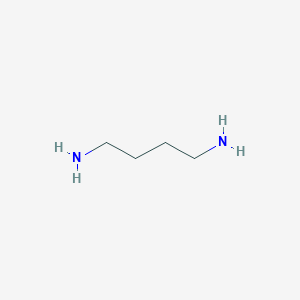Details of Metabolite
| Full List of Protein(s) Regulating This Metabolite | ||||||
|---|---|---|---|---|---|---|
| Hydrolases (EC 3) | ||||||
| Leukotriene-C4 hydrolase (GGT1) | Click to Show/Hide the Full List of Regulating Pair(s): 1 Pair(s) | |||||
| Detailed Information |
Protein Info
 click to show the details of this protein click to show the details of this protein
|
|||||
| Regulating Pair |
Experim Info
 click to show the details of experiment for validating this pair click to show the details of experiment for validating this pair
|
[1] | ||||
| Introduced Variation | Knockdown (siRNA) of GGT1 | |||||
| Induced Change | Putrescine concentration: increase | |||||
| Summary | Introduced Variation
|
|||||
| Disease Status | Renal cell carcinoma [ICD-11: 2C90] | |||||
| Details | It is reported that knockdown of GGT1 leads to the increase of putrescine levels compared with control group. | |||||
| Sulfatase sulf-1 (SULF1) | Click to Show/Hide the Full List of Regulating Pair(s): 1 Pair(s) | |||||
| Detailed Information |
Protein Info
 click to show the details of this protein click to show the details of this protein
|
|||||
| Regulating Pair |
Experim Info
 click to show the details of experiment for validating this pair click to show the details of experiment for validating this pair
|
[2] | ||||
| Introduced Variation | Knockdown (shRNA) of SULF1 | |||||
| Induced Change | Putrescine concentration: decrease (FC = 0.10 / 0.11) | |||||
| Summary | Introduced Variation
|
|||||
| Disease Status | Ovarian cancer [ICD-11: 2C73] | |||||
| Details | It is reported that knockdown of SULF1 leads to the decrease of putrescine levels compared with control group. | |||||
| Oxidoreductases (EC 1) | ||||||
| Alcohol dehydrogenase iron 1 (ADHFE1) | Click to Show/Hide the Full List of Regulating Pair(s): 1 Pair(s) | |||||
| Detailed Information |
Protein Info
 click to show the details of this protein click to show the details of this protein
|
|||||
| Regulating Pair |
Experim Info
 click to show the details of experiment for validating this pair click to show the details of experiment for validating this pair
|
[3] | ||||
| Introduced Variation | Overexpression of ADHFE1 | |||||
| Induced Change | Putrescine concentration: increase | |||||
| Summary | Introduced Variation
|
|||||
| Disease Status | Breast cancer [ICD-11: 2C60] | |||||
| Details | It is reported that overexpression of ADHFE1 leads to the increase of putrescine levels compared with control group. | |||||
| Transferases (EC 2) | ||||||
| Pyridoxal kinase (PDXK) | Click to Show/Hide the Full List of Regulating Pair(s): 2 Pair(s) | |||||
| Detailed Information |
Protein Info
 click to show the details of this protein click to show the details of this protein
|
|||||
| Regulating Pair (1) |
Experim Info
 click to show the details of experiment for validating this pair click to show the details of experiment for validating this pair
|
[4] | ||||
| Introduced Variation | Knockout (CRISPR/Cas9 sgRNA) of Pdxk | |||||
| Induced Change | Putrescine concentration: decrease | |||||
| Summary | Introduced Variation
|
|||||
| Disease Status | Acute myeloid leukaemia [ICD-11: 2A60] | |||||
| Details | It is reported that knockout of Pdxk leads to the decrease of putrescine levels compared with control group. | |||||
| Regulating Pair (2) |
Experim Info
 click to show the details of experiment for validating this pair click to show the details of experiment for validating this pair
|
[4] | ||||
| Introduced Variation | Knockout (CRISPR/Cas9 sgRNA) of PDXK | |||||
| Induced Change | Putrescine concentration: decrease | |||||
| Summary | Introduced Variation
|
|||||
| Disease Status | Acute myeloid leukaemia [ICD-11: 2A60] | |||||
| Details | It is reported that knockout of PDXK leads to the decrease of putrescine levels compared with control group. | |||||
| Translocases (EC 7) | ||||||
| Polyamine-transporting ATPase 13A2 (ATP13A2) | Click to Show/Hide the Full List of Regulating Pair(s): 1 Pair(s) | |||||
| Detailed Information |
Protein Info
 click to show the details of this protein click to show the details of this protein
|
|||||
| Regulating Pair |
Experim Info
 click to show the details of experiment for validating this pair click to show the details of experiment for validating this pair
|
[5] | ||||
| Introduced Variation | Knockout of ATP13A2 | |||||
| Induced Change | Putrescine concentration: decrease | |||||
| Summary | Introduced Variation
|
|||||
| Disease Status | Brain cancer [ICD-11: 2A00] | |||||
| Details | It is reported that knockout of ATP13A2 leads to the decrease of putrescine levels compared with control group. | |||||
If you find any error in data or bug in web service, please kindly report it to Dr. Zhang and Dr. Mou.

